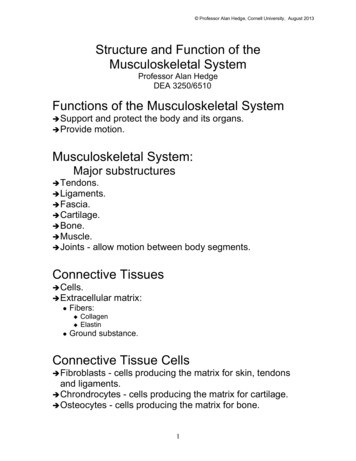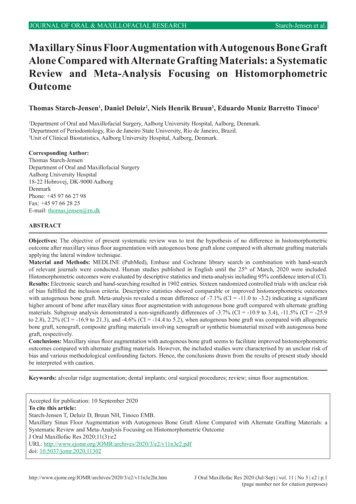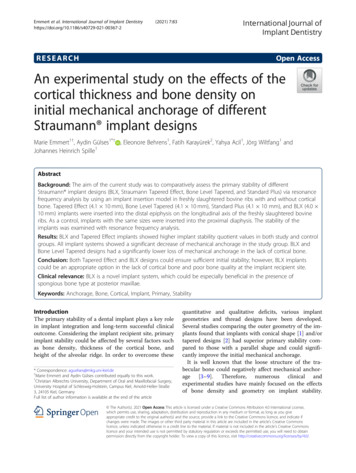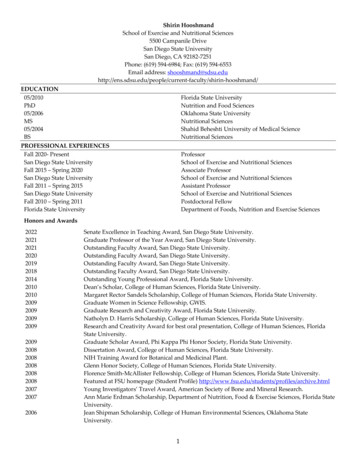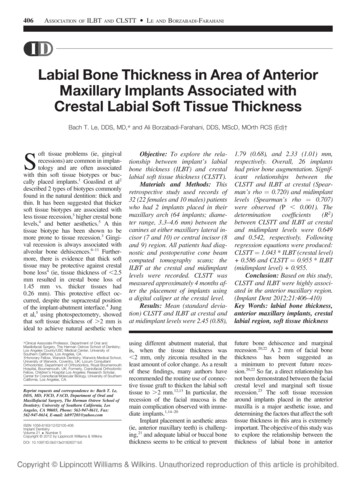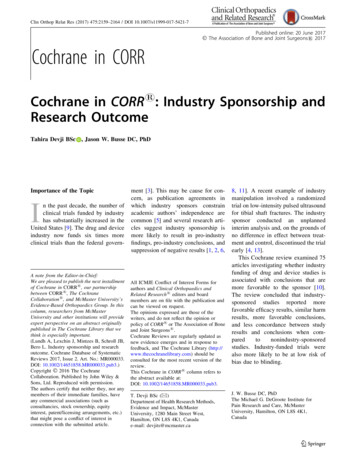
Transcription
Clin Orthop Relat Res (2017) 475:2159–2164 / DOI 10.1007/s11999-017-5421-7Clinical Orthopaedicsand Related Research A Publication of The Association of Bone and Joint Surgeons Published online: 20 June 2017Ó The Association of Bone and Joint Surgeons1 2017Cochrane in CORRCochrane in CORR1: Industry Sponsorship andResearch OutcomeTahira Devji BSc , Jason W. Busse DC, PhDImportance of the TopicIn the past decade, the number ofclinical trials funded by industryhas substantially increased in theUnited States [9]. The drug and deviceindustry now funds six times moreclinical trials than the federal govern-A note from the Editor-in-Chief:We are pleased to publish the next installmentof Cochrane in CORR1, our partnershipbetween CORR1, The CochraneCollaboration1, and McMaster University’sEvidence-Based Orthopaedics Group. In thiscolumn, researchers from McMasterUniversity and other institutions will provideexpert perspective on an abstract originallypublished in The Cochrane Library that wethink is especially important.(Lundh A, Lexchin J, Mintzes B, Schroll JB,Bero L. Industry sponsorship and researchoutcome. Cochrane Database of SystematicReviews 2017, Issue 2. Art. No.: MR000033.DOI: 10.1002/14651858.MR000033.pub3.)Copyright Ó 2016 The CochraneCollaboration. Published by John Wiley &Sons, Ltd. Reproduced with permission.The authors certify that neither they, nor anymembers of their immediate families, haveany commercial associations (such asconsultancies, stock ownership, equityinterest, patent/licensing arrangements, etc.)that might pose a conflict of interest inconnection with the submitted article.ment [3]. This may be cause for concern, as publication agreements inwhich industry sponsors constrainacademic authors’ independence arecommon [5] and several research articles suggest industry sponsorship ismore likely to result in pro-industryfindings, pro-industry conclusions, andsuppression of negative results [1, 2, 6,All ICMJE Conflict of Interest Forms forauthors and Clinical Orthopaedics andRelated Research1 editors and boardmembers are on file with the publication andcan be viewed on request.The opinions expressed are those of thewriters, and do not reflect the opinion orpolicy of CORR1 or The Association of Boneand Joint Surgeons1.Cochrane Reviews are regularly updated asnew evidence emerges and in response tofeedback, and The Cochrane Library (http://www.thecochranelibrary.com) should beconsulted for the most recent version of thereview.This Cochrane in CORR1 column refers tothe abstract available at:DOI: 10.1002/14651858.MR000033.pub3.T. Devji BSc (&)Department of Health Research Methods,Evidence and Impact, McMasterUniversity, 1280 Main Street West,Hamilton, ON L8S 4K1, Canadae-mail: devjits@mcmaster.ca8, 11]. A recent example of industrymanipulation involved a randomizedtrial on low-intensity pulsed ultrasoundfor tibial shaft fractures. The industrysponsor conducted an unplannedinterim analysis and, on the grounds ofno difference in effect between treatment and control, discontinued the trialearly [4, 13].This Cochrane review examined 75articles investigating whether industryfunding of drug and device studies isassociated with conclusions that aremore favorable to the sponsor [10].The review concluded that industrysponsored studies reported morefavorable efficacy results, similar harmresults, more favorable conclusions,and less concordance between studyresults and conclusions when comparedtononindustry-sponsoredstudies. Industry-funded trials werealso more likely to be at low risk ofbias due to blinding.J. W. Busse DC, PhDThe Michael G. DeGroote Institute forPain Research and Care, McMasterUniversity, Hamilton, ON L8S 4K1,Canada123
Clinical Orthopaedics and Related Research12160 Devji and BusseCochrane in CORRUpon Closer InspectionThis Cochrane review provided consistent evidence for the existence of anindustry bias. Most included studieswere categorized at high risk of bias;this assessment of risk of bias, however, was based on unvalidatedcriteria. Many of the included studieslacked information on study conductand did not control for confoundersthat could influence the relationshipbetween industry sponsorship andresearch outcomes. Furthermore, it isnot clear if the review accounted forthe effects of clustering. The inclusionof multiple reviews may have resultedin shared primary studies contributingmore than once to pooled effect estimates, potentially overestimating theassociation [10]. Despite these limitations, this review provides convincingevidence that industry-sponsoredstudies are more likely to report morefavorable efficacy results than nonindustry-sponsored studies.123This Cochrane review identified anumber of important findings in theirsubgroup analyses. For example, whenrestricted to studies at low risk of bias,the association between industry sponsorship and favorable results wasstronger and industry support was associated with less reporting of harms. Asubgroup analysis based on the type ofintervention found that industry-fundeddrug studies were more likely to reportfavorable results, whereas industry-funded device trials were less likely to reportfavorable results. Ideally, the authorswould have performed meta-regressionconsidering all promising subgroup factors to explore which ones retainedsignificance in an adjusted analysis.Take-home MessagesThis recently published Cochranereview found evidence that industrysponsorship is associated with morefavorable results and conclusions, andthis bias is not captured by standardrisk-of-bias assessments. The reviewauthors suggest that industry bias maybe mediated by choice of comparators(such as placebo vs. current goldstandard), dosing and timing of comparisons, choice of outcomes, selectiveanalysis, and selective reporting [7].When conducting a systematicreview and meta-analysis, authorsshould capture and report the prevalence of industry funding amongeligible primary studies and empirically explore, on an outcome-byoutcome basis, whether industryfunding is associated with systematicdifferences in treatment effects. If so,and the subgroup effect is deemedcredible based on established criteria[12], we believe review authors shouldfocus on studies that are not funded byindustry. If no credible subgroup effectis detected, then review authors canconfidentially pool results from studiesthat are industry funded with those thatare not.
Volume 475, Number 9, September 2017Cochrane in CORR1 2161Cochrane in CORRAppendix123
2162 Devji and BusseCochrane in CORR123Clinical Orthopaedics and Related Research1
Volume 475, Number 9, September 2017Cochrane in CORR1 2163Cochrane in CORR123
Clinical Orthopaedics and Related Research12164 Devji and BusseCochrane in CORRReferences1. Bekelman JE, Li Y, Gross CP. Scopeand impact of financial conflicts ofinterest in biomedical research: Asystematicreview.JAMA.2003;289:454–465.2. Bhandari M, Busse JW, JackowskiD, Montori VM, Schünemann H,Sprague S, Mears D, Schemitsch EH,Heels-Ansdell D, Devereaux PJ.Association between industry funding and statistically significant proindustry findings in medical andsurgical randomized trials. Can MedAssoc J. 2004;170:477–480.3. Ehrhardt S, Appel LJ, Meinert CL.Trends in national institutes of healthfunding for clinical trials ��2567.4. Griffin XL. Low intensity pulsedultrasound for fractures of the tibialshaft. BMJ. 2016;355:i5652.5. Kasenda B, von Elm E, You JJ,Blümle A, Tomonaga Y, SaccilottoR, Amstutz A, Bengough T, Meerpohl JJ, Stegert M, Olu KK,Tikkinen KA, Neumann I, CarrascoLabra A, Faulhaber M, Mulla SM,Mertz D, Akl EA, Bassler D, Busse123JW, Ferreira-González I, Lamontagne F, Nordmann A, Gloy V,Raatz H, Moja L, Ebrahim S,Schandelmaier S, Sun X, VandvikPO, Johnston BC, Walter MA,Burnand B, Schwenkglenks M,Hemkens LG, Bucher HC, GuyattGH, Briel M. Agreements betweenindustry and academia on publication rights: A retrospective study ofprotocols and publications of randomized clinical trials. PLoS Med.2016;13:e1002046.6. Lexchin J, Bero LA, Djulbegovic B,Clark O. Pharmaceutical industrysponsorship and research outcomeand quality: Systematic review.BMJ. 2003;326:1167–1170.7. Lundh A, Lexchin J, Mintzes B,Schroll JB, Bero L. Industry sponsorship and research outcome.Cochrane Database Syst Rev.2017;2:MR000033.8. Melander H, Ahlqvist-Rastad J,Meijer G, Beermann B. Evidenceb(i)ased medicine—selective reporting from studies sponsored bypharmaceutical industry: Review ofstudies in new drug applications.BMJ. 2003;326:1171–1173.9. Moses H 3rd, Matheson DH, CairnsSmith S, George BP, Palisch C,Dorsey ER. The anatomy of medicalresearch: US and international comparisons. JAMA. 2015;313:174–189.10. Senn SJ. Overstating the evidence:Double counting in meta-analysisand related problems. BMC Med ResMethodol. 2009;9:10.11. Stamatakis E, Weiler R, Ioannidis J.Undue industry influences that distort healthcare research, strategy,expenditure and practice: A review.Eur J Clin Invest. 2013;43:469–475.12. Sun X, Briel M, Walter SD, GuyattGH. Is a subgroup effect believable?Updating criteria to evaluate thecredibility of subgroup analyses.BMJ. 2010;340:c117.13. TRUST Investigators writing group,Busse JW, Bhandari M, Einhorn TA,Schemitsch E, Heckman JD, Tornetta P 3rd, Leung KS, HeelsAnsdell D, Makosso-Kallyth S,Della Rocca GJ, Jones CB, GuyattGH. Re-evaluation of low intensitypulsed ultrasound in treatment oftibial fractures (TRUST): Randomized clinical trial. BMJ. 2016;355:i5351.
Take-home Messages This recently published Cochrane . Lexchin J, Bero LA, Djulbegovic B, Clark O. Pharmaceutical industry sponsorship and research outcome and quality: Systematic review. BMJ. 2003;326:1167-1170. 7. Lundh A, Lexchin J, Mintzes B, . Della Rocca GJ, Jones CB, Guyatt GH. Re-evaluation of low intensity



